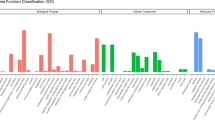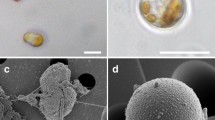Abstract
Three Gracilaria species, G. chouae, G. blodgettii, G. vermiculophylla and a close relative species, Gracilariopsis lemaneiformis which is now nominated as Gracilaria lemaneiformis, are the typically indigenous species which are important resources for the production of special proteins, phycobilisomes, special carbohydrates, and agar in China. In this study, de novo transcriptome sequencing on these four species using the next generation sequencing technology was performed for the first time. Functional annotations on assembled sequencing reads showed that the transcriptomic profiles were quite different between G. lemaneiformis and other three Gracilaria species. Comparative analysis of differential gene expression related to carbohydrate and phycobiliprotein metabolisms also showed that the expression profiles of these essential genes were different in four species. The genes encoding allophycocyanin, phycocyanin and phycoerythrin were further examined in four species and their deduced amino acid sequences were used for phylogenetic analysis to confirm that G. lemaneiformis had close relationship to genus Gracilaria, as well as that within genus Gracilaria, G. chouae had closer relationship to G. vermiculophylla rather than to G. blodgettii. The de novo transcriptome study on four species provided a valuable genomic resource for further understanding and analysis on biological and evolutionary study among marine algae.
Similar content being viewed by others
References
Altschul S F, Madden T L, Schaffer A A, et al. 1997. Gapped BLAST and PSI-BLAST: a new generation of protein database search programs. NAR, 25(17): 3389–3402
Arnold W, Oppenheimer J R. 1950. Internal conversion in the photosynthetic mechanism of blue-green algae. The Journal of General Physiology, 33(4): 423–435
Cock J M, Sterck L, Rouze P, et al. 2010. The Ectocarpus genome and the independent evolution of multicellularity in brown algae. Nature, 465(7298): 617–621
De Gasperi R, Gama Sosa M A, Kim S H, et al. 2012. Acute blast injury reduces brain abeta in two rodent species. Frontiers in Neurology, 3: 177
Dufosséa L, Galaupa P, Yaronb A. 2005. Microorganisms and microalgae as sources of pigments for food use: a scientific oddity or an industrial reality. Trends in Food Science and Technology, 16: 389–406
Everroad R C, Wood A M. 2012. Phycoerythrin evolution and diversification of spectral phenotype in marine Synechococcus and related picocyanobacteria. Molecular Phylogenetics and Evolution, 64(3): 381–392
French C S, Young V K. 1952. The fluorescence spectra of red algae and the transfer of energy from phycoerythrin to phycocyanin and chlorophyll. J Gen Physiol, 35(6): 873–890
Gantt E, Conti S F. 1966. Phycobiliprotein localization in algae. Brookhaven Symposia in Biology, 19: 393–405
Glazer A N. 1997. Phycobiliproteins: A family of valuable, widely used fluorophores. Scanning, 19: 154–155
Gray M W. 1992. The endosymbiont hypothesis revisited. Int Rev Cytol, 141: 233–357
Hagopian J C, Reis M, Kitajima J P, et al. 2004. Comparative analysis of the complete plastid genome sequence of the red alga Gracilaria tenuistipitata var. liui provides insights into the evolution of rhodoplasts and their relationship to other plastids. J Mol Evol, 59(4): 464–477
Hall T A. 1999. BioEdit: a user-friendly biological sequence alignment editor and analysis program for Windows 95/98/NT. Nucleic Acids Sympsium Series, 41: 95–98
Huovinen P, Gomez I, Lovengreen C. 2006. A five-year study of solar ultraviolet radiation in southern Chile (39 degrees S): potential impact on physiology of coastal marine algae? J Photochem Photobiol, 82(2): 515–522
Johnson M T, Carpenter E J, Tian Z, et al. 2012. Evaluating methods for isolating total RNA and predicting the success of sequencing phylogenetically diverse plant transcriptomes. PLoS One, 7(11): e50226
Kanehisa M, Goto S. 2000. KEGG: kyoto encyclopedia of genes and genomes. Nucleic Acids Res, 28(1): 27–30
Kimura M. 1980. A simple method for estimating evolutionary rates of base substitutions through comparative studies of nucleotide sequences. Journal of Molecular Evolution, 16(2): 111–120
Lapointe B E, Duke C S. 1984. Biochemical strategies for growth of Gracilaria tikvahiae (Rhodophyta) in relation to light intensity and nitrogen availability. J Phycol, 20(4): 488–495
Li Ruiqiang, Zhu Hongmei, Ruan Jue, et al. 2010. De novo assembly of human genomes with massively parallel short read sequencing. Genome Research, 20: 265–272
Liu Luning, Chen Xiulan, Zhang Xiying, et al. 2005. One-step chromatography method for efficient separation and purification of R-phycoerythrin from Polysiphonia urceolata. J Biotechnol (in Chinese), 116(1): 91–100
Marinho S E. 2001. Agar polysaccharides from Gracilaria species (Rhodophyta, Gracilariaceae). J Biotechnol, 89(1): 81–84
Moriya Y, Itoh M, Okuda S, et al. 2007. KAAS: an automatic genome annotation and pathway reconstruction server. NAR, 35(Web Server issue): W182–185
Nyvall P, Pedersen M, Kenne L, et al. 2000. Enzyme kinetics and chemical modification of alpha-1,4-glucan lyase from Gracilariopsis sp. Phytochemistry, 54(2): 139–145
Pan Jiangqiu, Li Sidong. 2010. Development and Utilization of Gracilaria Resources. Chinese Journal of Tropical Agriculture (in Chinese), 30(10): 47–50
Romualdi C, Bortoluzzi S, D’Alessi F, et al. 2003. IDEG6: a web tool for detection of differentially expressed genes in multiple tag sampling experiments. Physiol Genomics, 12(2): 159–162
Shih C M, Cheng S N, Wong C S, et al. 2009. Antiinflammatory and antihyperalgesic activity of C-phycocyanin. Anesth Analg, 108(4): 1303–1310
Steentoft M, Farham W F. 1997. Northern distribution boundaries and thermal requirements of Gracilaria and Gracilariopsis (Gracilariales, Rhodophyta) in Atlantic Europe and Scandinavia. Nord J Bot, 5(5): 87–93
Tamura K, Peterson D, Peterson N, et al. 2011. MEGA5: molecular evolutionary genetics analysis using maximum likelihood, evolutionary distance, and maximum parsimony methods. Mol Biol Evol, 28(10): 2731–2739
Tatusov R L, Fedorova N D, Jackson J D, et al. 2003. The COG database: an updated version includes eukaryotes. BMC Bioinformatics, 4: 41
Tatusov R L, Natale D A, Garkavtsev I V, et al. 2001. The COG database: new developments in phylogenetic classification of proteins from complete genomes. NAR, 29(1): 22–28
Thompson J D, Higgins D G, Gibson T J. 1994. CLUSTAL W: improving the sensitivity of progressive multiple sequence alignment through sequence weighting, position-specific gap penalties and weight matrix choice. NAR, 22(22): 4673–4680
Xu Shannan, Wen Shanshan, Wu wangxin, et al. 2008. Bioremediation of caged fish aquaculture by the red alga Gracilaria verrucosa in an integrated multi-trophic aquaculture system. Acta Ecologica Sinica (in Chinese), 967
Zhang Xuecheng, Fei Xiugeng, Wang Guangce, et al. 2009. Genetic studies and large scale cultivation of gracilaria lemaneiformis. Periodical of Ocean University of China (in Chinese), 39(5): 947–954
Zhang Junfu, Xia Bangmei. 1992. Studies on two new Gracilaria from South China and a summary of Gracilaria species in China. Taxonomy of Economic Seaweeds, 3: 195–206
Author information
Authors and Affiliations
Corresponding authors
Additional information
Foundation item: The National Natural Science Foundation of China under contract Nos 31140070, 31271397 and 41206116; the algal transcriptome sequencing was supported by 1KP Project (www.onekp.com).
Contributed equally.
Rights and permissions
About this article
Cite this article
Xu, J., Sun, J., Yin, J. et al. Comparative analysis of four essential Gracilariaceae species in China based on whole transcriptomic sequencing. Acta Oceanol. Sin. 33, 54–62 (2014). https://doi.org/10.1007/s13131-014-0441-6
Received:
Accepted:
Published:
Issue Date:
DOI: https://doi.org/10.1007/s13131-014-0441-6




